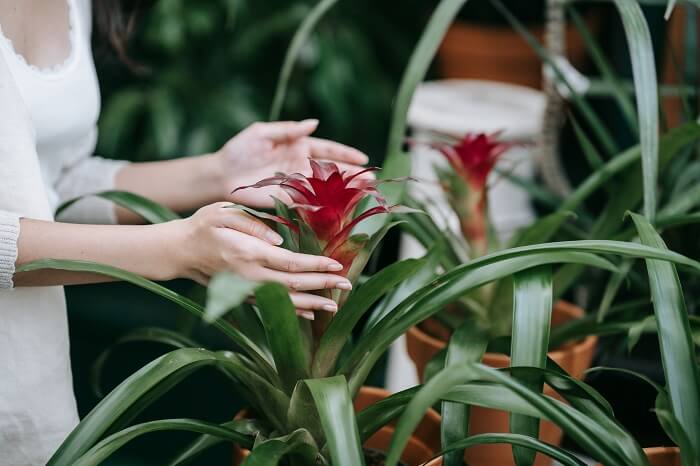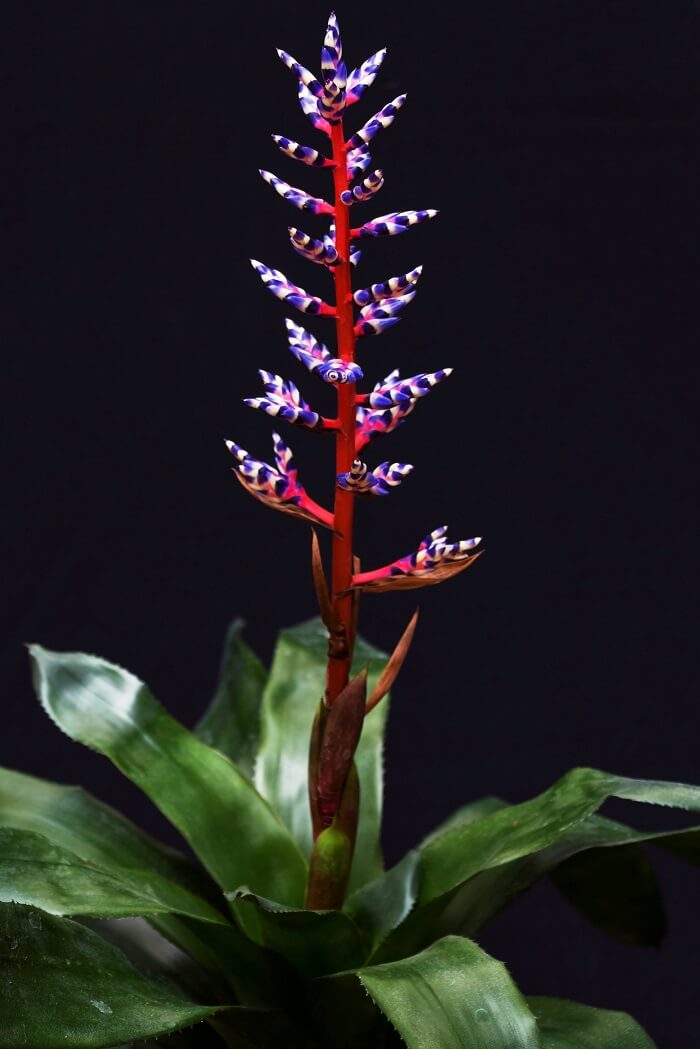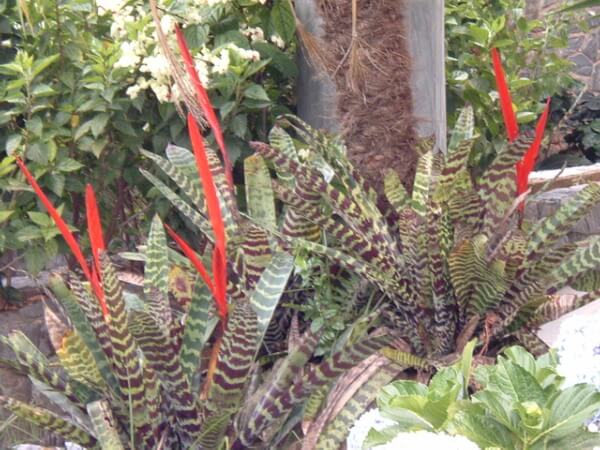Plant Care Instructions for Bromeliad Vriesea Splendens, Bromeliad Vriesea Splendens repotting, care tips, lighting, soil, watering, temperature tips.
Distribution and habitat:
Vriesea splendens is native to Venezuela and Trinidad, Guyana and Suriname. In its natural habitat, Vriesea splendens is growing terrestrially between the roots of trees in a soil rich in mold of leaves, but mostly it is based on growing epiphytes in dense forests in humid areas with shade. It has the typical bromeliad rosette shape and water vase.
Description:
Vriesea splendens is appreciated for its beautiful foliage and its showy spikes of flowers, being one of the most showy and dramatic bromeliads. It has rigid, sword-shaped leaves with soft edges arranged in a loose rosette that is capable of retaining the water in the center in the form of a cup. The rosette is made up of approximately 20 leaves of 38 cm (15 inches) long and 3-5 cm (1-2 inches) wide, which are dark green with crossed bands of purple-black color.
Like other bromeliads, Vriesea splendens does not flower until it is between three and five years old. Their spikes of strongly colored flowers, usually erect, in the shape of a sword, which can be produced at different times of the year depending on the conditions, are very durable, an effect derived largely from the bright bracts instead of the ephemeral flowers. The floral spike up to 60 cm (24 inches) tall is covered by a 30 cm (12 inch) flattened leaf of overlapping bright red bracts; 3-5 cm (1-2 inches) long yellow tubular flowers emerge from this. The beak persists for several months, after which the plant slowly decreases while producing one or more offsets.
There are many forms of Vriesea splendens, some with darker foliage, the same with larger flower spikes or of different shapes.

Source : pexels.com
Care of the indoor plant:
Vriesea splendens are suitable subjects to grow in a bromeliad tree: the roots are wrapped in a ball of sphagnum moss and connected to a dead branch or piece of floating wood. They should not be allowed to dry out and will need foliar feeding.
These bromeliads are not as easy to grow as other bromeliads, but they will be successful when they provide bright light, warm temperatures and moderate to high humidity.
Light:
Vriesea splendens should have a bright light with three or four hours a day of direct sunlight, to flower. However, do not expose them to the scorching midday sun.
Temperature:
Vriesea splendens needs normal temperature and high humidity; To increase humidity, it is recommended to place pots in trays of wet pebbles. Protect this bromeliad from temperatures below 10 ° C (50 ° F).
Watering:
Water actively by growing plants abundantly by filling the central cup of the rosette until the water spills into the axils of the leaves and seeps through the potting mix. During the short day, the Vriesea splendens can rest and should be watered enough so that the earth mixture is hardly wet.
Refill the vase of water every two weeks with fresh water. Spray leaves weekly. Use soft water if possible. Let the water stand for several hours before using it.
Feeding:
Give all active growing plants medium-strength liquid fertilizer about once a month. Apply the fertilizer to both the pot mix and the center cup. Do not fertilize during the rest period.

Source : pexels.com
Pots and transplant:
Use the recommended mixture for bromeliads. Two possible mixes of pots consist of equal parts of thick leaf mold and peat moss or equal parts of lime-free and peat moss-free land mixture. Repot Vriesea splendens only when the roots fill their pots, every two or three years, this is best done in spring. The largest pot size required is 13 cm (5 inches). When reapplying these plants, do not pack the potting mix too firmly; the roots can not penetrate the heavy soil.
Gardening:
Vriesea splendens prefers a sunny to mid-shade situation in moderately humid soils. They are resistant to zone 10. It can be planted in the soil in a soil rich in humus or attached to the side of a fern tree. In summer, plants prefer moderate humidity and need protection from direct sunlight. Bring this bromeliad in during the winter months. Propagate a new plant from the hatchlings when the parent plant is about to expire.
Propagation:
Around the time of flowering, Vriesea splendens will produce displacements of the armpits of the leaves or around the base of the rosettes. A basal shift should be 8-15 cm (3-6 inches) long (depending on the size of the mature plant) before being separated with a sharp knife; retain the roots if they have already been produced. Plant the compensation in an 8 cm (3 inch) pot of standard humid bromeliad mixture, seal it in a plastic bag and keep it in a warm place with bright filtered light until the roots are established (in about four to six weeks) . Then, treat the young plant as recommended for mature Vriesea splendens.
The displacement that arises from the leaf should not be separated, but should grow naturally. They will replace the father (who after flourishing, dies slowly) for a period of about one year.
Also Vriesea splendens can be propagated from the seed. The seeds must be freshly harvested since they lose their viability quickly. Sow the seeds in the spring and use a pot or shallow pot filled with a mixture of two parts of peat and one part of coarse sand. Sprinkle the seeds thinly and evenly over the surface, pressing them gently without burying them. After completely moistening the potting mix, place the container in a plastic bag or in a heated propagation box. If it is maintained at a temperature of about 24-27 ° C (75-81 ° F) the fresh seeds will germinate in a week or two.
Leave the seedling still enclosed in the bag or box, in a warm position that receives filtered bright light until they have formed three or four leaves. Once the leaves have appeared, gradually allow more air to pass into the bag or box to accustom the seedlings to the normal conditions of the room for a period of 7 to 10 days. After the seedlings are completely uncovered, begin to water them moderately, allowing the top centimeter (0.4 inches) or so of the potting mix to dry out between waterings; Start feeding once a month liquid fertilizer at half your strength. When the seedlings have made at least six leaves, place each pot in a 5- or 8-cm (2-3 inch) pot of one of the recommended pot mixes for adult bromeliads and treat them as mature plants.

Source : wikipedia.org
Problems:
Brown patches on the leaves can be caused by exposure to direct sunlight. In addition, leaf spots can be a sign of a fungal or bacterial infection. Bacterial spots are quite angular and with yellow borders, while fungal spots are generally quite rounded with an area of fruiting bodies.
Treatment: Destroy the affected parts, apply an additional fungicide in cases of fungal infection. The brown tips on the leaves usually indicate insufficient moisture in the air or the bromed vase has not been filled with water. Sudden withering and pale green discoloration indicate a fungal infection (phytophthora).
Treatment: eliminate infected plants. Avoid more infections by improving drainage and avoiding over-fertilization. Scale insects that sit on the underside of the leaves and excrete honeydew.
Treatment: Scale insects can be controlled with insecticide. Putrefaction in the base may be due to excess water in the pot mix. Putrefaction at the base, if the plant has flowered, may be due to the natural death of the original rosette.
Uses and visualization:
Vriesea splendens is suitable as a container plant and as an indoor plant. The vibrant colors of the leaves make this bromeliad a unique focal point, even when the plant is not in bloom. Since the extension of this plant is wide, a good location is an elevated platform or support plant, with other low-light plants used as accents below. It is widely used as a container plant in indoor commercial sites.
Vriesea splendens can be grown as an epiphyte plant mounted on a piece of bark or a tree branch. The young Vriesea splendens that emerge from the seeds can be used for bottle or terrarium gardens, since this bromeliad is a slow grower.
Bromeliad Vriesea Splendens
- Light: lots of light
- Temperature: 75° to 78° F – 24° to 26° C
- Humidity: 40%
- Soil: black and peat-moss
- Watering: two or three times a week
- Spraying: daily
This plant has green leaves, zebra-striped with brown; the bracts are red and the flower yellow. It flowers only once. After the blooms have faded, the flower stalks should be cut back. After a time, you will see new plants appearing at the foot of the plant. They should be sectioned off with as much root as possible and repotted. This plant needs plenty of warmth and humidity, as well as considerable light, but never full sunshine. The leaves should be sprayed daily and diluted fertilizer applied regularly. From spring to fail, you may leave some water standing in the heart of the plant, but this water should be renewed regularly. Remember to water and spray only with tepid water. This plant requires low, well-drained pots. The soil should be light and well-ventilated.